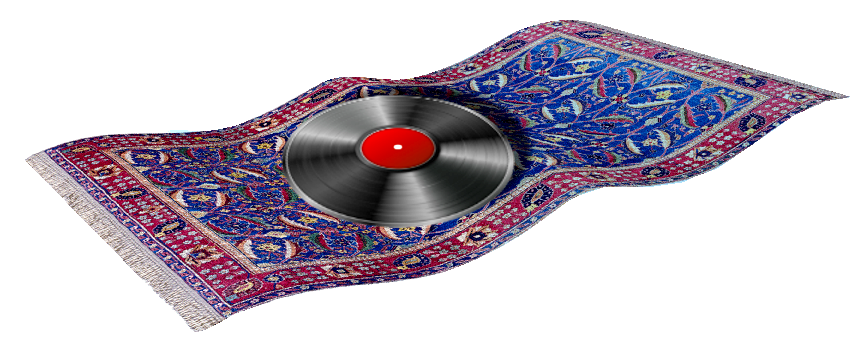
What would I wish for from a turntable mat?
The following list of reasons is hopefully uncontentious.
- To protect the record from the hard metal platter (if employed).
- To prevent scratches from dust trapped between the record and the turntable.
- To damp the resonance of a metal turntable (if used).
- To support the record (ideally over its entire surface) so that it damps vibrations.
- To transmit the torque of the drive platter to the plastic disc.
- To reduce the inevitable static electric charge on the surface of a plastic record.
- To look nice.
The last item on the list may appear frivolous but, during the time when a turntable is not being used — which is probably for the majority of the time, it is the mat which dominates the look of the unit.
Translating this into physical requirements. We need a turntable mat material which is:
- Resilient and flexible;
- Acoustically dead;
- ❝Grippy❞ - has a high coëfficient of friction;
- Electrically conductive; and
- Attractive.
Hard materials, please leave
Apart from their striking appearances, it is difficult to make the case for non-resilient materials in this application. We want the record support-mat to protect the soft PVC copolymer material from the metal parts of the turntable (if one is employed) and we want it cushion the record so as to damp any vibration in the record and the turntable. And we want the material to grip the surface of the record so as to transfer the torque of the turntable to the medium. Hard, inflexible materials cannot fulfil these requirements.
Material hardness was codified during the early 1800s by German mineralogist Friedrich Mohs . He devised a scale and test which is still in use today. The essence of Mohs test is,
❝That which scratches is harder than that which has been scratched.❞It doesn't take too much imagination to imagine that brass and copper leave a nice scratch upon a record. (Test it if you like!) Since we know we don't want scratched records, these materials represent an inappropriate choice for a turntable mat. The only advantage of copper and brass is that they conduct electricity and may thus play a rôle in reducing static electricity buildup on the playing surface; especially when a non-metallic platter is employed (see below).
Worst of all, hard mats demand an impossible level of cleanliness because, any house dust (which is mostly silica and much harder then the record) trapped between the mat and the record will damage the record — especially if the record moves relative to the mat.
Matched impedance, please leave
A case might be made for a rigid material if it betrayed some striking mechanical advantage. We were attracted by the impedance match argument (see panel) in the hope that a better energy absorber might be available. But a few simple experiments (see panel) and Appendix 2 reveal that the matched impedance theory doesn't apply in this application.
The trouble with these matched impedance transmission line type arguments is that, whilst it is true that reflections take place due to impedance mismatches, adding another length of "line" does not make the problem go away; it simply postpones it. Reflected energy is no less of a problem because it is delayed. Doubling the length of an organ pipe doesn't stop it sounding ! The trick is to terminate the line in a dissipating element, not to extend it.
Insulators, please leave
In his paper Record Contamination: Causes and Cure¹, Percy Wilson studied the effect of static electrical charge on the surface of a vinyl record and the rôle it plays in the contamination of record grooves. He said,
❝An interesting experiment [is to] electrify both surfaces of a disc by rubbing with a piece of silk .... I now place a piece of aluminum foil on one surface and the net charge on the other surface is neutralized. I remove the foil and the charge flows back again. Hence the value of a conductive turntable mat ..... ❞ ¹
Wilson's paper offered an explanation for the mechanism of the effect in terms of Volta's Electrophorus.¹
❝The negative charge on the insulator attracts an equal positive charge on the conductor. Then the charges appear as shown.... The positive charge on the conductor and the negative charge on the insulator are close together and produce no net field on the outside of the insulator. ❞
The effect was confirmed in later quantitative experiments by Anderson of Shure Brothers Inc.4 Anderson pointed out that the effect could more easily be explained by recognising that, in bringing the conductor close to the charged surface (the record), the capacitance is increased greatly, 7 and, since the charge is constant, the voltage must decrease in accordance with the equation V = Q/C.
Anderson demonstrated that the external electric field on top face of the record may be reduced by 90% by placing it on a grounded turntable. Not enough to neutralise the problem completely (Anderson offered further solutions for this in the form of a carbon fibre brush which could bleed off the rest of the charge), but an improvement that it is foolish to relinquish.
Unfortunately, this renders cork unsuitable (and acrylic, wood and glass doubly so) although in almost every other way cork would seem to be a suitable material (see Appendix 2 and note. 12).
The finalists
In fact, the insistence on soft, conductive materials has nearly left us with no finalists at all. Our remaining three materials: felt; leather; and rubber are all insulators too! However, it is possible to modify all of them to be conductive. Rubber has been modified in this way for many years for its use in car and aeroplane tyres. If the tyres were not conductive, dangerous static charges could build up which could cause an explosion during refuelling.
There has been work to make leather conductive for use as clothing, for example leather gloves which allow the wearer to interact with touchscreens. And there has been work to develop electrically conductive felt. However, conductive leather and felt are still relatively rare and it is not clear that all (or, indeed any!) of the commercial products available use electrically conductive materials.
Leather

Highly flexible at ambient temperatures and humidities, most types of leather exhibit viscoelastic behaviour which make it appear suitable both a record protector and as a vibration damper.
However, leather is susceptible to supporting fungal growth and this should sound a warning regarding the transfer of mycelial fragments to records. Being an organic material, leather may not always provide a flat, homogeneous surface which counts against it in this application. Leather will also crack and peel over time. Applying a suitable conditioner which is chemically compatible with record materials and cleanliness is not straightforward.
Leather played a significant role as an engineering material in the early industrial revolution where it was widely used for drive belts - a rôle not too dissimilar to the turntable mat. But it has almost everywhere been replaced by by rubber or synthetic polymer materials. Surely there is a lesson to be learnt from history here.
Felt
Felt plays an important rôle as a turntable mat for the DJ where it is called a slipmat.³ The techniques of the DJ (now part of the musical form dubbed turntablism), involve the turntable platter being left to rotate at a constant speed and the record manuipulated with the felt mat acting as a torque limiter which may be slipped by the braking force of the DJ's hands.
This is a legitimate use of the a turntable mat, of course, but torque-limiting isn't the function we are looking for in a record mat for straightforward listening or for needle-drops where even the hint of slippage is most unwelcome. We want our turntable mat to transfer the maximum power of the driven turntable to the record and, in this, we have an outstanding winner.
Lap of honour
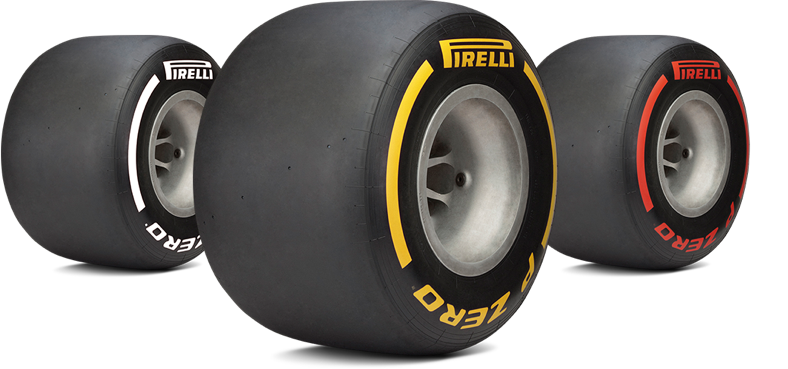 Rubber offers a very large surface area in contact with another object. Made of long carbon polymer chains with hydrogen attached along the length the chain, rubber offers high friction for two, complementary reasons. 1) it can flex enough to have more atoms available for interaction than almost any other material and 2) its constituent hydrogen atoms are “stickier” than the atoms present in most other materials.10
Rubber offers a very large surface area in contact with another object. Made of long carbon polymer chains with hydrogen attached along the length the chain, rubber offers high friction for two, complementary reasons. 1) it can flex enough to have more atoms available for interaction than almost any other material and 2) its constituent hydrogen atoms are “stickier” than the atoms present in most other materials.10
It is these "magic" properties of rubber which have kept it as the material for road tyres from runabouts to racing cars for over 100 years. The rubber must be rendered conductive to be suitable in this rôle, but that is a standard industrial process.
The only drawback with rubber is that it is probably the least attractive of the materials discussed.
Now we have a material, what shape do we make it?
All manufacturing standards from the heyday of microgroove records allow for records with different profiles. The first profile, the so called, flush design, is a simple, a pure disc of vinyl with a diameter of 301.6mm ±0.8mm and a thickness of 1.9mm ±0.3mm. (These are the RIAA numbers, but other standards were very similar.)
Alternative profiles (cross-sections) were specified and were known as raised-rim, raised-label (IEC standard), or contour-design (RIAA). The RIAA verion of the raised-rim, raised-label standard is illustrated above (and the Japanese version below).
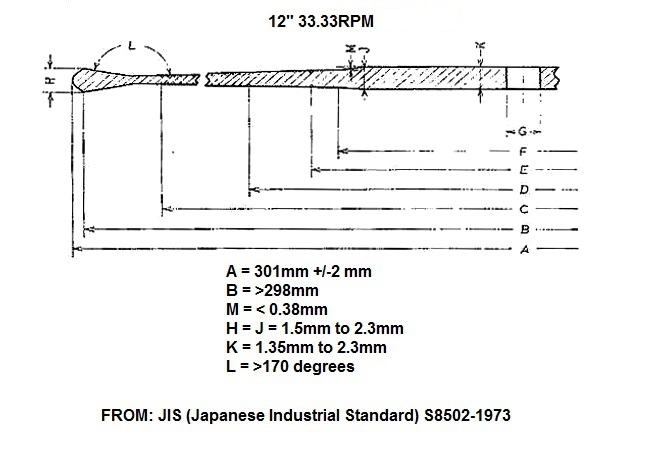 The origin of the contour idea comes from the development of the 45 RPM 7" record by RCA. This format was conceived so that a stack of discs could sit on an autochanger deck. By means of a mechanical release in the central spindle, records were designed to fall down and play sequentially; each disc sitting on top of its predecessor.
The origin of the contour idea comes from the development of the 45 RPM 7" record by RCA. This format was conceived so that a stack of discs could sit on an autochanger deck. By means of a mechanical release in the central spindle, records were designed to fall down and play sequentially; each disc sitting on top of its predecessor.
In order that this stacking process didn't trash the recording-surface of the records by having them touch each other, the central, label area of the 45 RPM record is always moulded so that it is much thicker than the plastic annulus on which the grooves are moulded. The recording surfaces are thereby kept apart.
The contoured 12" record was the solution to enable LP records be stacked and automatically played in the same way as 45s. Because the playing surface was so much broader than with the 7" 45 RPM record, the extra rim was added to stop the playing side "drooping" when separated by the proud label section.
What is the width dimension of the rim bead?
Not specified directly in any of the standards, the rim width dimension must be calculated. This is done in the graphic below. It indicates that the flat part of the contoured record only extends to a diameter of about 292mm (11½ inches).
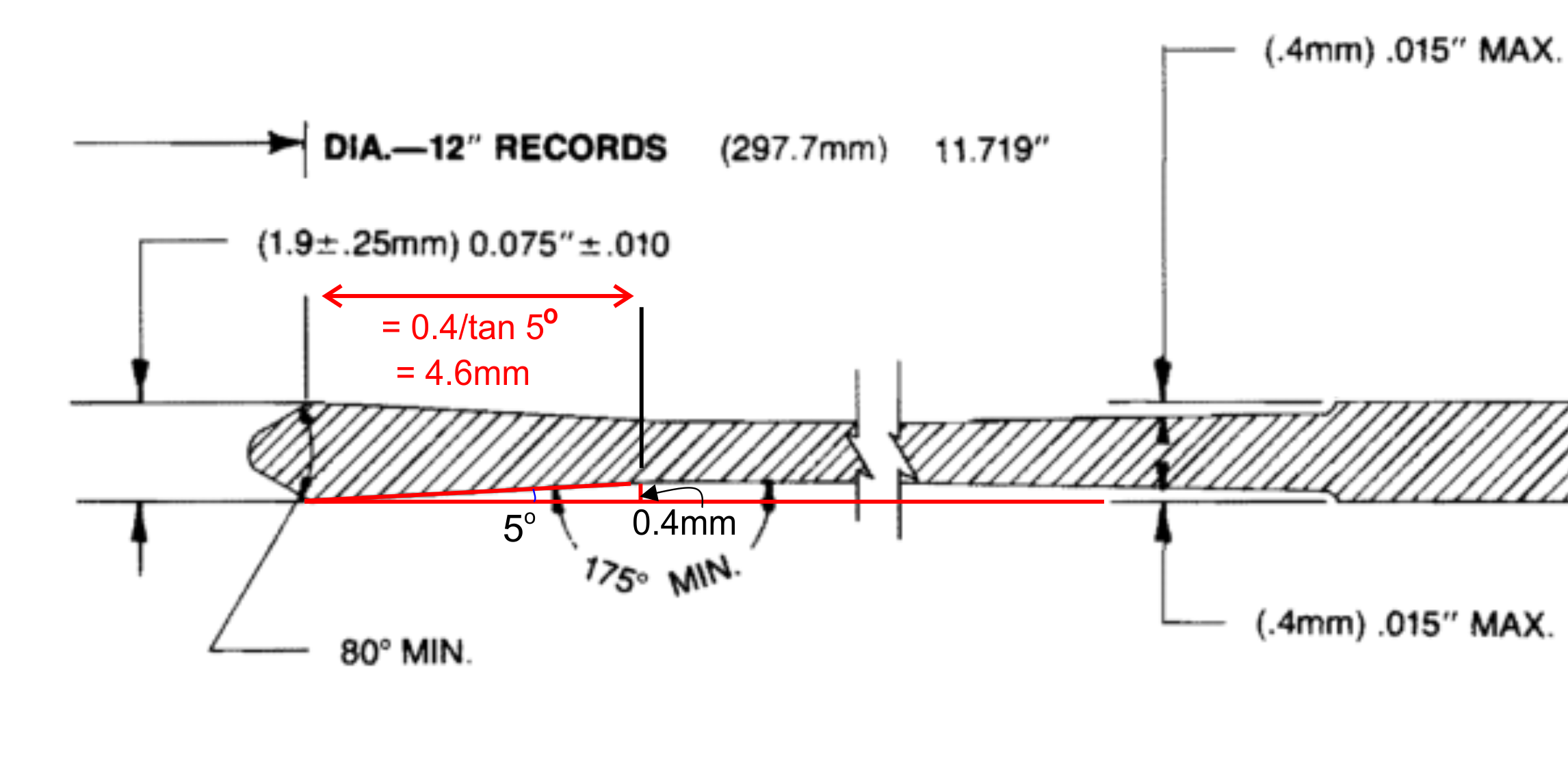
A small sample
Whether or not autochanger functionality was much used, we discovered in our own collections, a great many LPs which are moulded with the contour profile. Frankly, this was unexpected. The profile is quite subtle and, we had never noticed how many records were manufactured with a contour.
In fact, the standard IEC 68(1964) allowed for, a raised rim or a raised label area or both and we easily found examples of records with all four possible profiles.
Any record-mat with a claim to legitimacy (especially for a collector or archivist) must cater for all four possible record profiles which we annotate:
- Plain disc (flush design)
- Raised label
- Raised rim
- Raised label and raised rim
The centre recess or well
Designers of turntable mats appear divided between the need to offer a centre recess for records manufactured with the raised-rim, raised-label profile (see panel for examples of each). The simple, flat turntable mat is a throwback to the days of the 78 RPM record which were always manufactured as a plain (flush) disc.14
The limitation of the pure, flat disc mat is that, should the record have the contoured profile, the mat will only contact the record in the label area and around the raised, annular bead at the edge of the disc: the playing surface is essentially unsupported. This is illustrated below (this time using the drawing from the British Standard profile, to illustrate that it was more or less identical to the American and Japanese standards.)
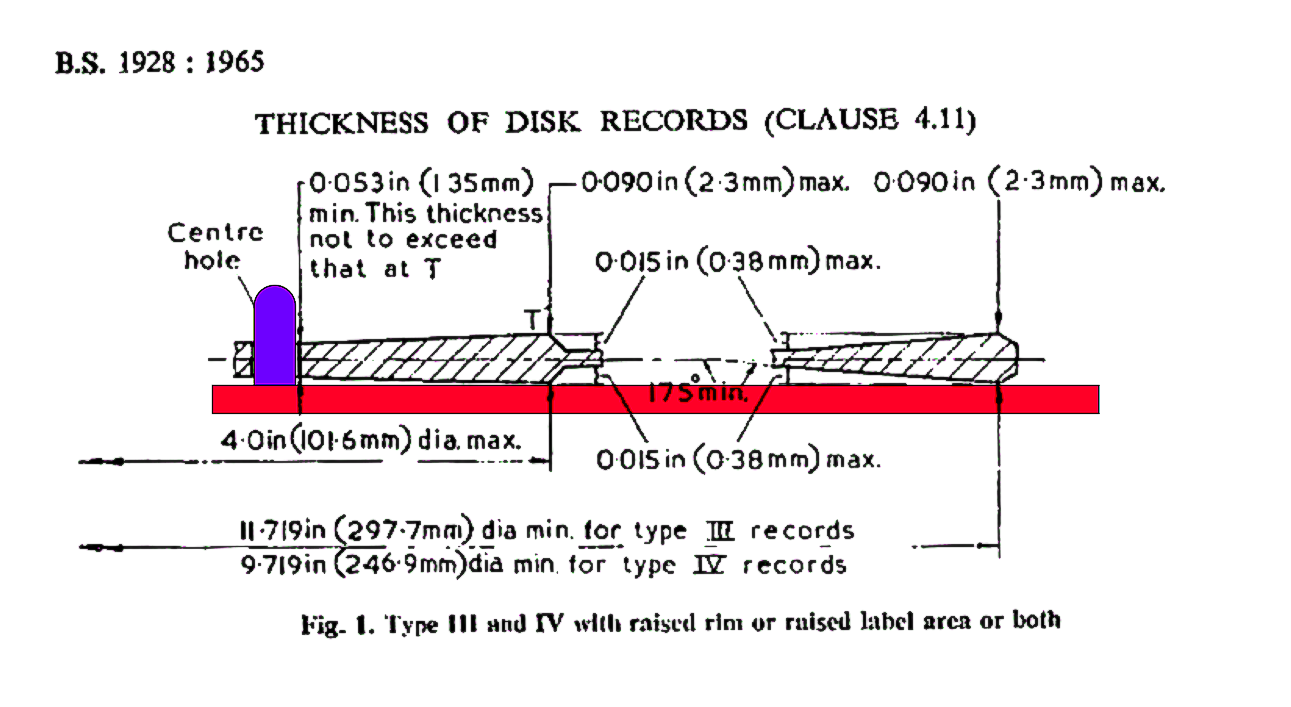
Maximum contact
Thinking in terms of the turntable mat as both a friction clutch and also as an acoustic damper, it's clear that we want, in both cases, to maximise the contact area of the mat and record. Indeed we might say this was the primary requirement. (It is this consideration which led us to the choice of rubber as the best material — because it maximised surface contact at a microscopic level.)
In terms of the mat design, the maximum contact surface is obtained when a flush-design (type.1) record sits on a mat which is a plain, flat disc. Providing the mat is made of a yielding, resilient material, the drive will be communicated over its entire π × (151mm)² = 0.072m² surface.
The contoured record, driven by the same flat mat, will only be driven at the hub, or the rim of the record, or both. At best, this reduces the contact area to little more than π × (51mm)² = 0.008m², or just 11% of the contact afforded the flush (type.1) disc.
How deep the well?
Measurements and manufacturers' information reveal that many of these central chambers, when the designer has chosen to include them, are 0.5mm deep.
According to all the various manufacturing standards, the record hub stands 0.38mm proud of the playing surface in a contoured record. The intention of a well 0.5mm deep is presumably to clear the central boss. But, if this is the case, a slightly deeper chamber would be wise. (0.005" clearance is needlessly "tight".)9
Reasonable sacrifices
If a recess has been provided in the design of the turntable mat, the flush record (type.1) will remain unsupported in the label area. But this is a reasonable sacrifice because the label area only represents, as we saw above, about 11% of the total area of the record. If the clearance is sufficient, the same is true for the type.2 record with a raised hub (but no raised rim).
But there's a major flaw in the central recess design when playing raised-rim (type. 3) and raised-rim, raised-label (type.4) records. In either case, the record will only be supported at its outer edge. In this situation, the centre chamber design scores substantially worse than the fully flat design when playing type.4 records.
The answer to this limitation is to sacrifice another small area of contact and reduce the diameter of the mat to about 290mm and let the proud annular edge drop below the level of the mat as illustrated below. The reduction in surface area with 10mm off the diameter is only about 8% compared to the flush record on a flat mat. This design secures the maximum contact area for all four types of record profile.
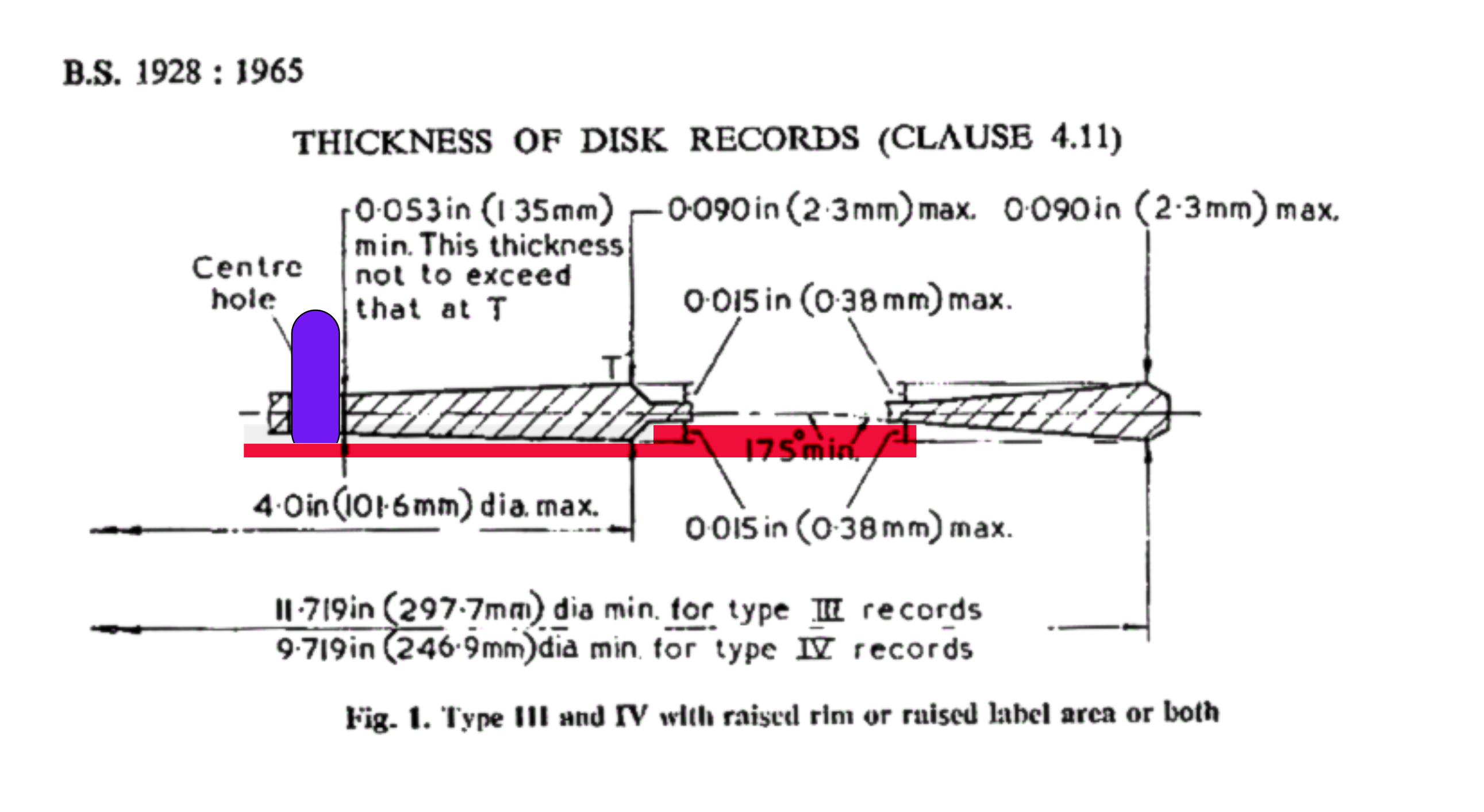
A table makes this easier to appreciate why the the 290mm diameter mat with a deep central chamber is the best design. It provides good and consistent drive and damping properties for all profiles of record.
Table. 1 Contact area of mat and record depending on mat and record configuration
|
Type of mat/type of record |
Type.1 |
Type.2 |
Type.3 |
Type.4 |
|
Flat |
100% |
11% |
1%* |
12% |
|
Centre chamber |
89%** |
89%** |
1%* |
1%* ** |
|
Chamber & 290mm diameter |
81% |
81%** |
81% |
81%** |
* Nominal figure, when only rim contacts with mat.
** Figure assumes the mat chamber never contacts the central hub of the record (raised or not).

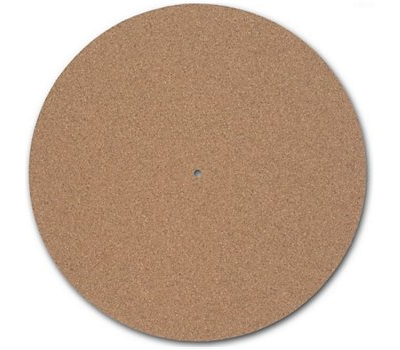
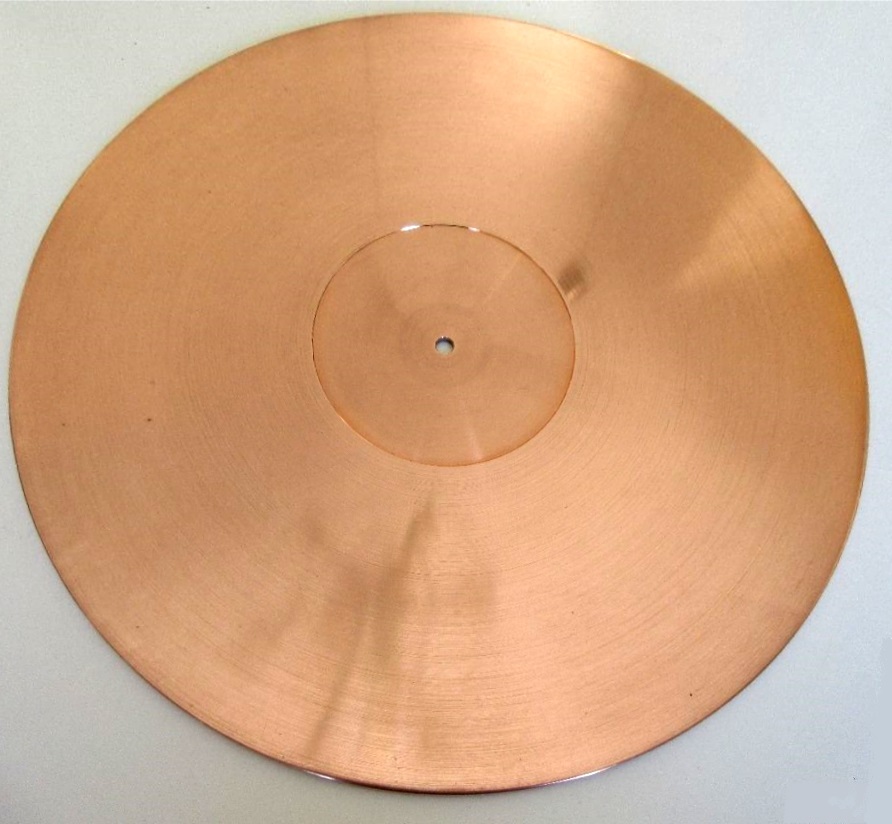
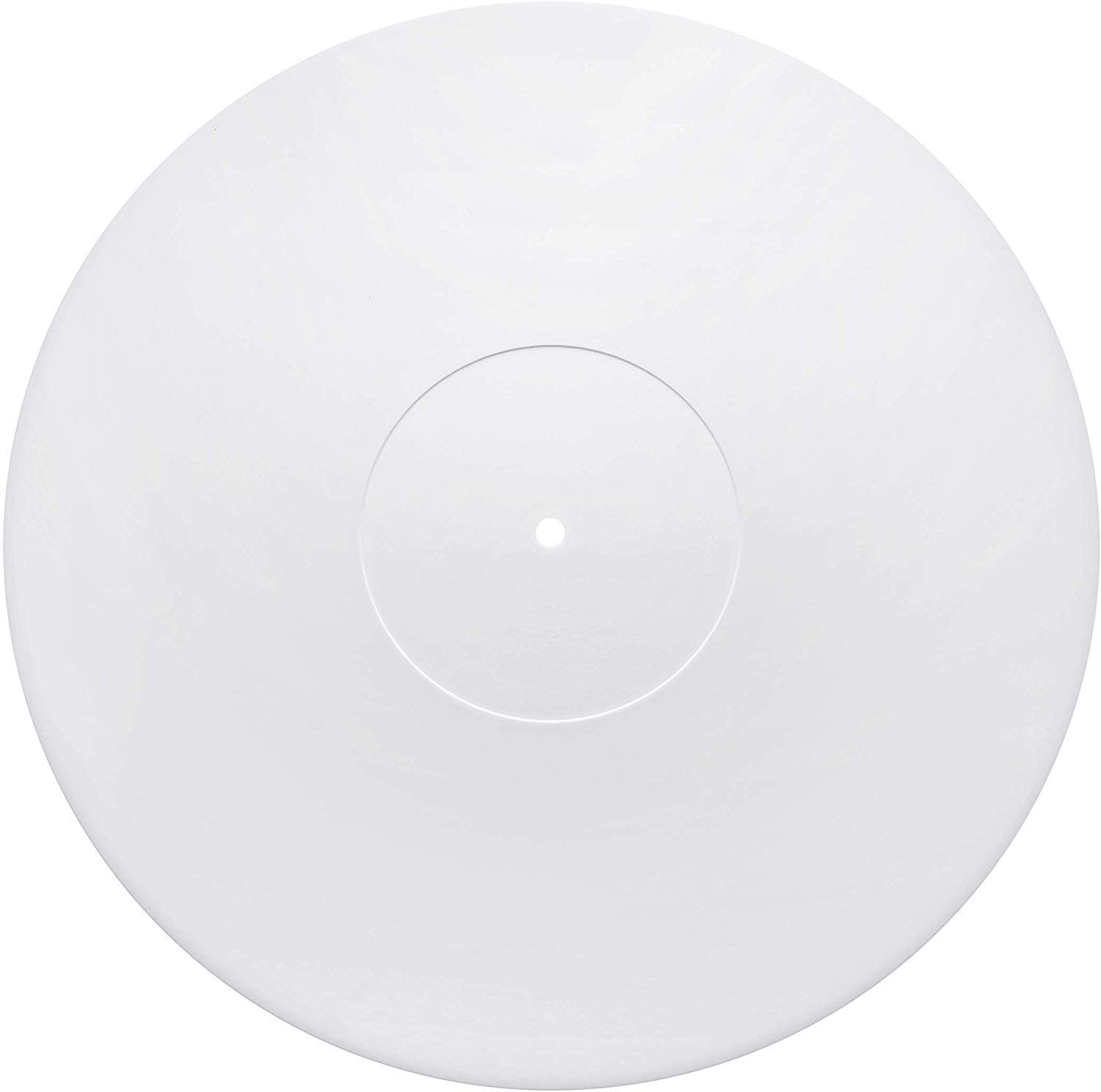
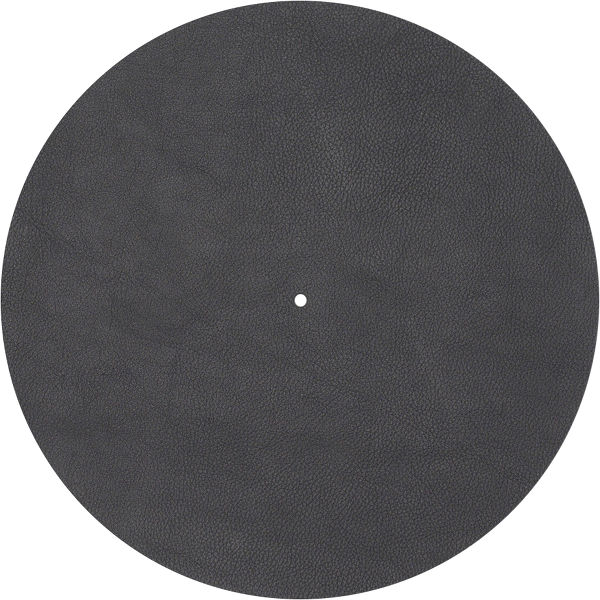
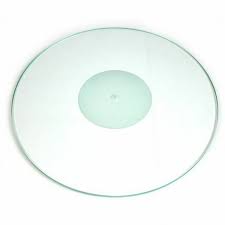
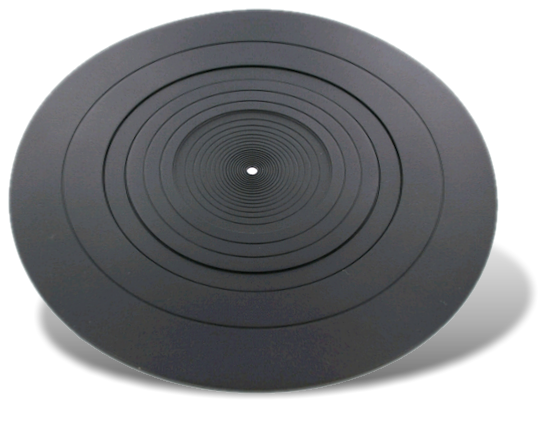
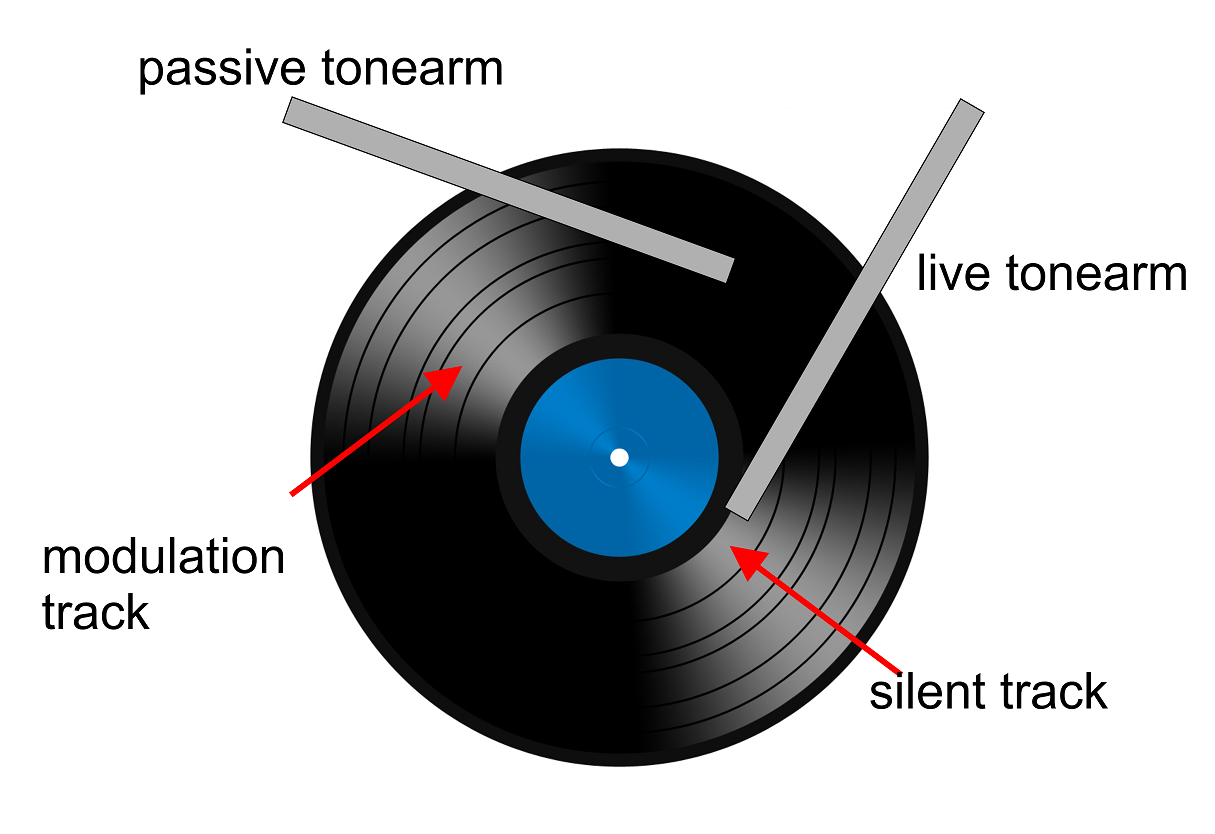

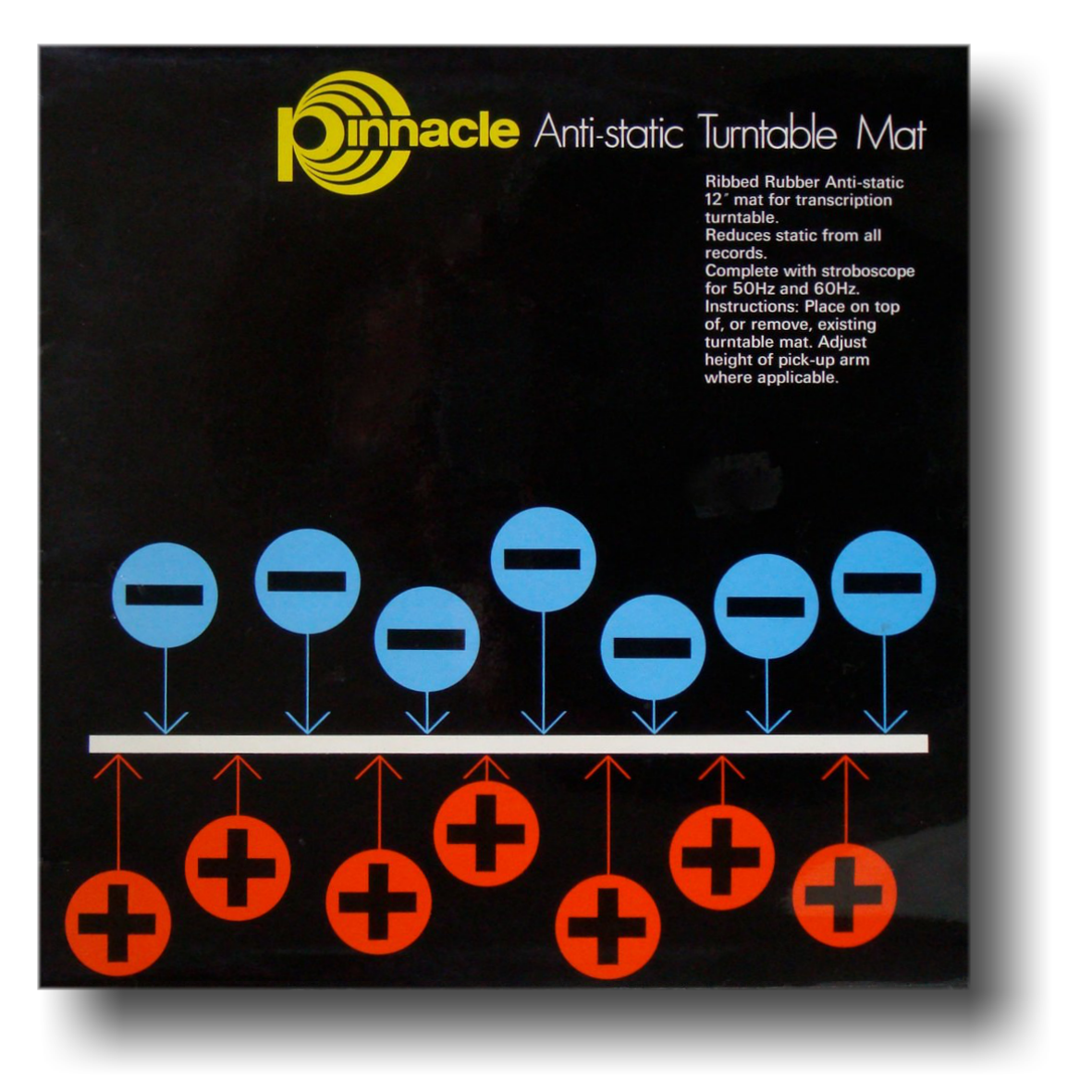 Yet, this unremarkable conclusion hides a remarkable truth. It is astonishingly difficult to fulfil!
Yet, this unremarkable conclusion hides a remarkable truth. It is astonishingly difficult to fulfil!
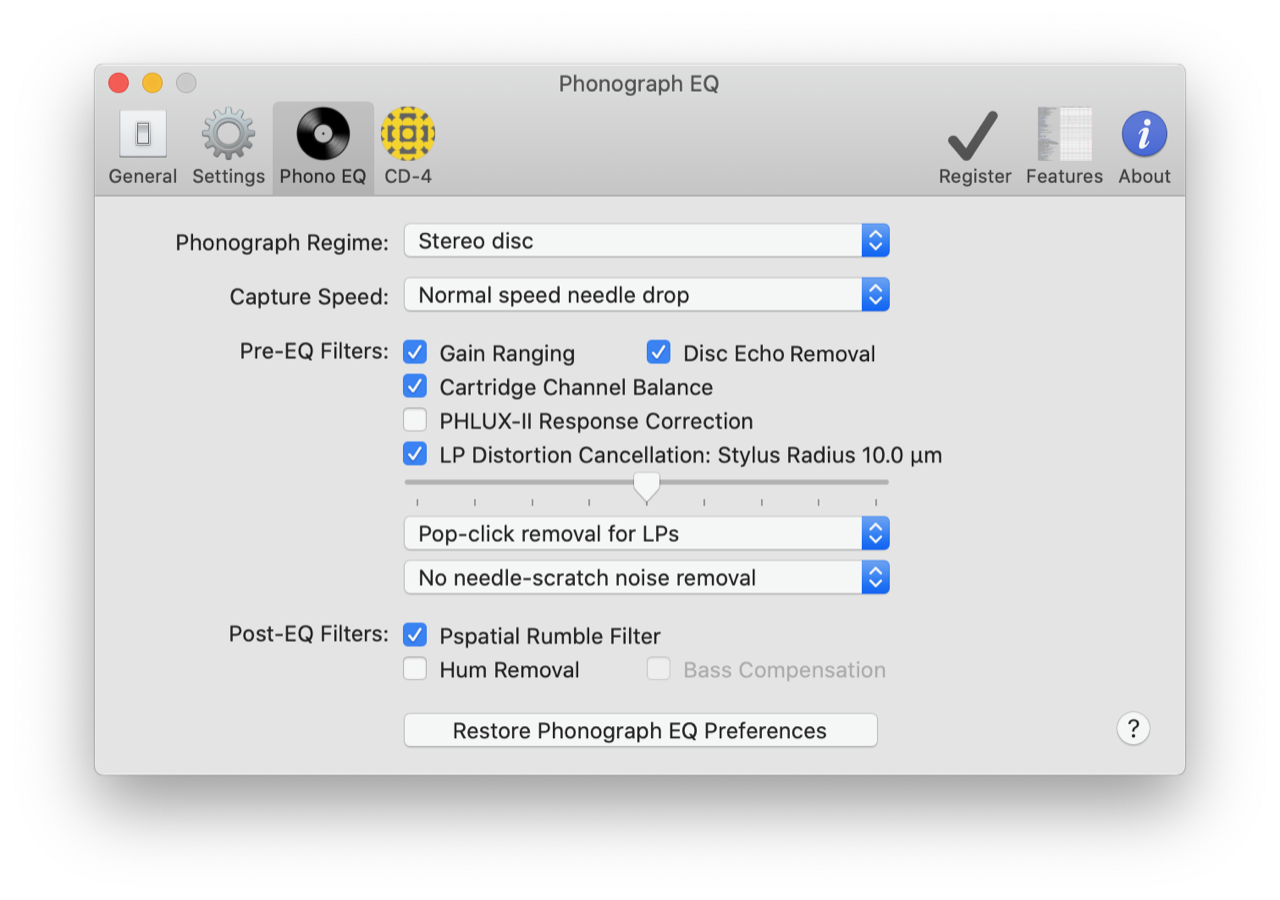
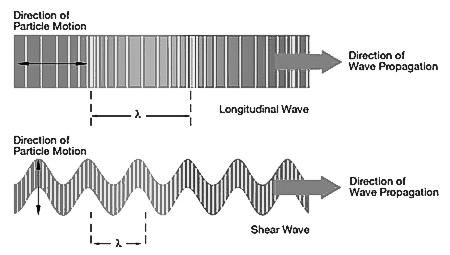 The turntable mat tests involved fitting an extra tonearm on a standard direct-drive record deck; complete with cartridge but with no amplification. All this tonearm does is to track the record and provide the reaction of the stylus impedance. The original tonearm is used as the echo pickup.
The turntable mat tests involved fitting an extra tonearm on a standard direct-drive record deck; complete with cartridge but with no amplification. All this tonearm does is to track the record and provide the reaction of the stylus impedance. The original tonearm is used as the echo pickup.
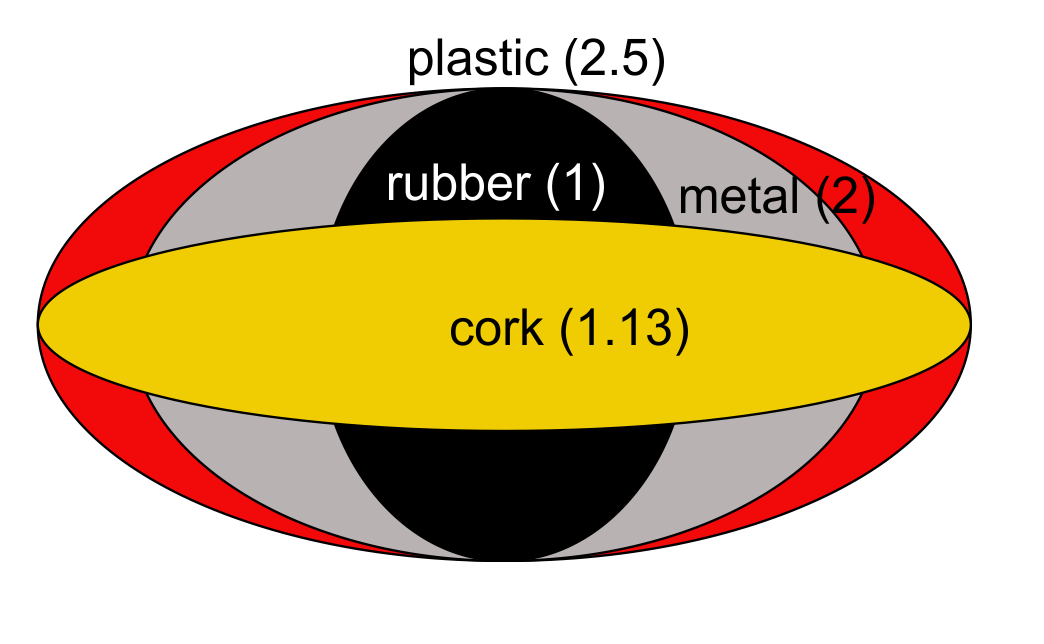 The numerical results are fine as far as they go. But we found that we needed a way of visualising the longitudinal wave and shear wave echo energy so as to compare the results more meaningfully.
The numerical results are fine as far as they go. But we found that we needed a way of visualising the longitudinal wave and shear wave echo energy so as to compare the results more meaningfully.
 Natural rubber is one of the simplest natural polymers. It consists of long chain-molecules which consist of repeating blocks of isoprene (illustrated right). There may be tens of thousands of such blocks in one molecule of natural rubber.
Natural rubber is one of the simplest natural polymers. It consists of long chain-molecules which consist of repeating blocks of isoprene (illustrated right). There may be tens of thousands of such blocks in one molecule of natural rubber.
